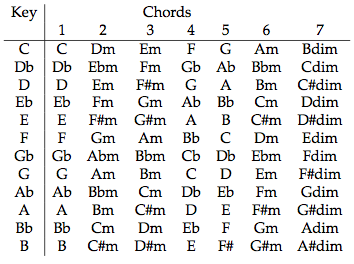The Chords of the Major Scale
On a previous lesson we have seen the major scale from a melodic point of view. Today we will have a look at the chords that come from the major scale and how they allow us to compose songs with minimal work and good results.
Chord Structure
Any major scale is associated with a set of seven chords - three major, three minor, one diminished. Precisely how and why this happens will be the topic of a future lesson. Right now I want to focus on few easy-to-understand facts that are of immediate practical use. Let’s see them:
- The chords from a scale are strictly related with the notes on a scale; a C major scale is made by the notes C D E F G A B (see here our previous lesson on the major scale). The chords associated with the C major scale are C major, D minor, E minor, F major, G major, A minor, B diminished. In other words, every note in the scale is associated with a chord.
- The chord structure for the major scale is the same for all keys. With this I mean that the order in which the major and minor chords appear is always the same. The first note on a major key is always associated with a major chord, the second note always with a minor chord, and so on.
Rather than having you go through all the major scales to compile a list of all the chords in them, I did all the work for you and prepared a table. It contains all the chords in all major keys.

Ok, But What Does It Mean?
Here are some other important facts you need to know about chords.
- With the exception of the diminished chord (which has some special ways to use it, and so we will ignore it for the time being), the chords in a key can be played one after the other in any order and they will sound good.
- You do not need to use ALL the chords in a key. For instance in the key of C you can decide to use only the chords C, F, and G.
- Most of the time a chord progression in a major key will start and end on the first chord of the key (i.e. a progression in C major will usually start and end on C). The first chord will always sound “final” in all keys.
- In fact ALL THE KEYS ARE EQUIVALENT. It does not matter in what key are you writing, the only thing that matters is the position of the chord in the key. Example: the progression C F G (in C major) and the progression D G A (in d major) are actually the same progression since they are both made by the 1st, 4th, and 5th chord in the respective keys. The two progressions actually sounds the same, with the only difference that the progression in D is higher in pitch than the one in C.
As an example of the last fact, let’s consider the song “Knocking on Heaven’s door” (originally by Bob Dylan, the cover by Guns ’n’ Roses being maybe more famous). The song uses the following chords: G D Am G D C. We can see easily that this song is in G major: it starts with a G chord, it eventually ends with a G chord and all the chords listed are in the key of G (check in the table below).

If we write down the numbers of the chord in the key of G as in the table, we get 1 5 2 1 5 4. Now we can play the same song in any other key, just by following the numbers: for instance the same song in C will be C G Dm C G F. This procedure is called transposition and it’s used for instance when a song is too high or too low to be sung comfortably.
Random Composition
Another application is to use these chords to compose songs. Here I will describe a way to compose chord progressions with practically no work. Let’s take the key of C for this example
- Throw a dice 3 times and write the resulting numbers down. As an example, let’s assume that you got 5,6,4.
- Start with the first chord in the key (in the key of C the first chord is C).
- Look at the first number you got from the dice (5) and take the corresponding chords. In the key of C, the 5th chord is G.
- Do the same for the other numbers. We obtain the chord progression C G Am F.
You can play this chord progression and try to hum a melody over it. If you like what you did, you have just composed a song. Otherwise you can start again with either a new chord progression, or just by changing some chords in what you obtained already. With a bit of trial and error you will be able to write some interesting music.
And if you want to go beyond trial and error and become a Master of Chords and Harmony On Guitar then click on the button below and read carefully the page that will appear:
